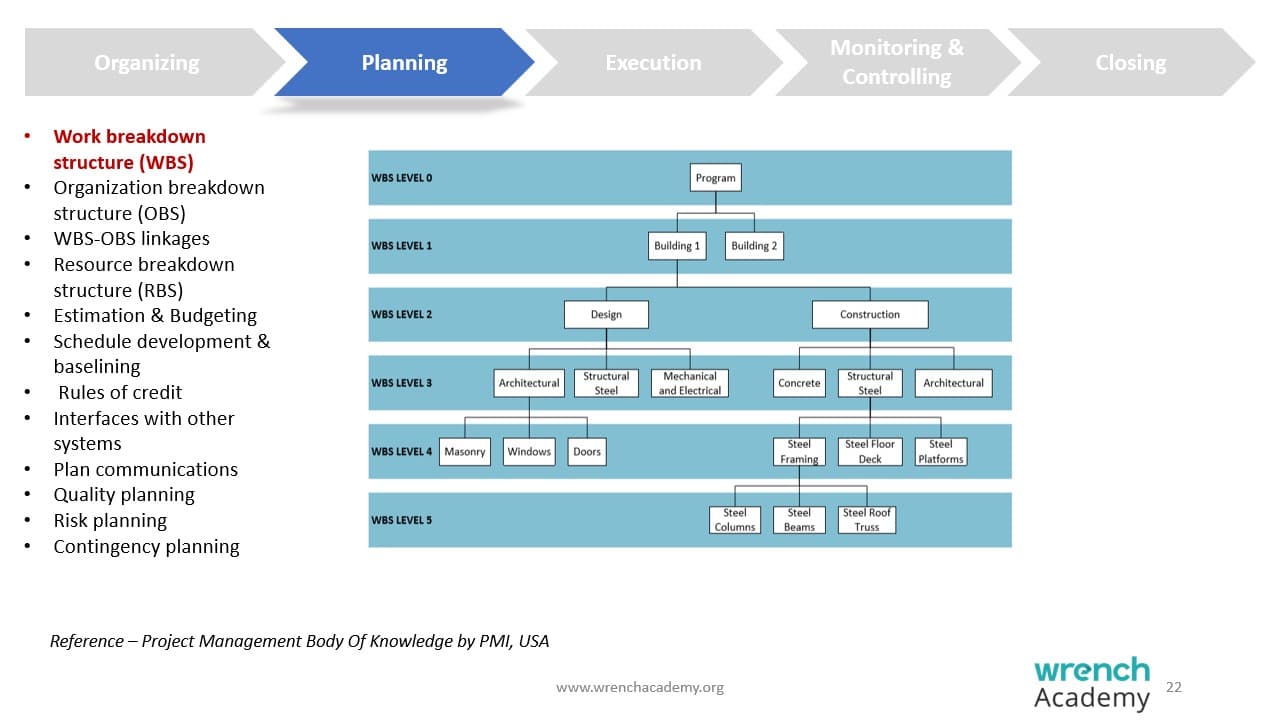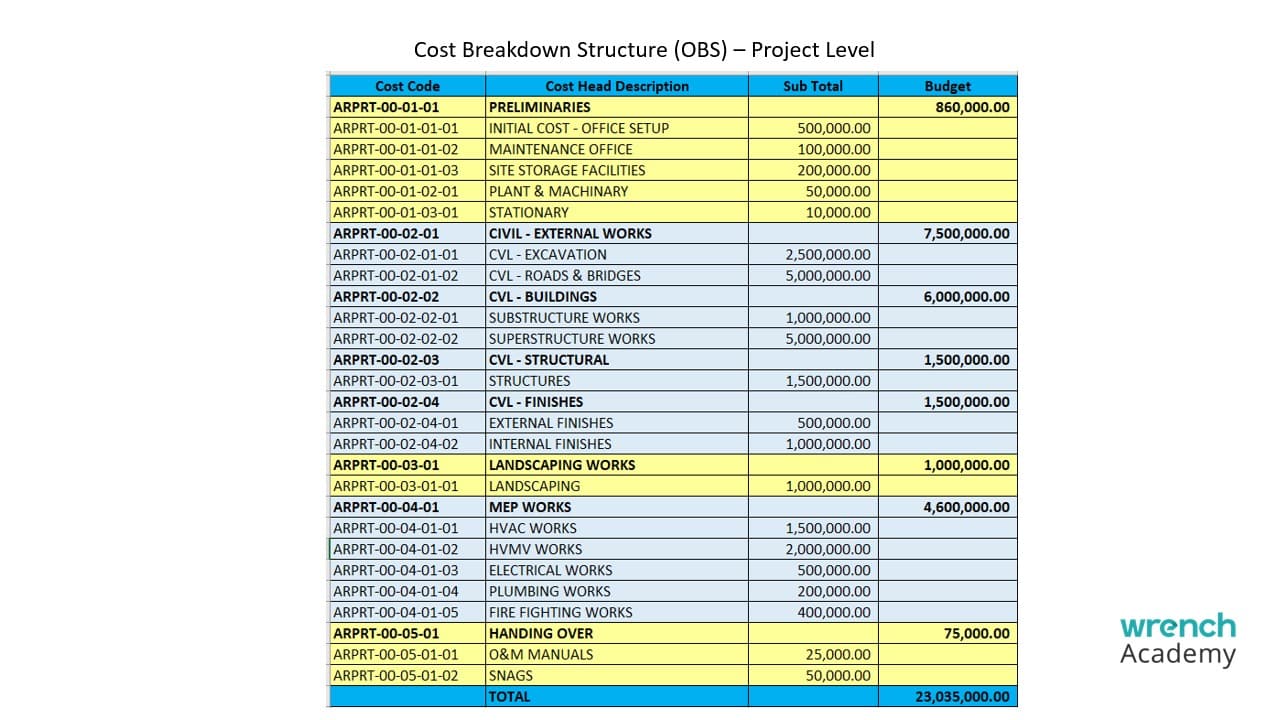Work Breakdown Structure
Work Breakdown Structure
Learning Objective
Upon successful completion of this module, you will;
- Know different types of Work Breakdown Structures (WBS)
- Understand the reasons for poor quality of WBS
- Learn the WBS design principles
- Understand the purpose and contents of WBS dictionary
- Learn to Develop Work Breakdown Structures (WBS)
- Learn to Develop work breakdown structure (WBS) dictionaries
Effort required – 1 hour
Lesson Introduction
Without a good Work Breakdown Structure (WBS), an accurate estimate of the project is impossible. All definitive estimates demand an estimation accuracy percentage ranging between -2 to +2 percentage, and it is impossible to achieve this kind of estimation accuracy without a good quality work breakdown structure. While starting a project from ground zero, the planner (very often the project manager himself) may grope around in the dark for a while without knowing where to start and end the planning process. The first and foremost step is to understand the scope of the project and the product, in-order to decompose them into a good quality work breakdown structure, which forms the basis for further planning, monitoring and controlling of the project.

What is a Work Breakdown Structure?
Ever since the first WBS was developed by United States Department of Defence (DoD) in 1962, it has become the essential component of every project management framework (PMBOK, PRINCE, TCM). A WBS is the heart of the project management system. WBS is closely linked into project scope & execution strategy development, and project control plan implementation. A WBS can make or break the project.
Communication tool
The WBS is a great tool for explaining the scope of work to other key stakeholders. I have found work breakdown structure as a effective tool for communicating scope with clarity to the relevant stakeholders.
Basis for developing the Project’s execution strategy
While developing the WBS, one will get more insights into the development of the project’s execution strategy. For example, one can decide which all work packages must be sub-contracted and which all must be done in-house.
Different types of Work breakdown structures
Based on the project domain, disciplines and purpose there are different flavours of work breakdown structures;
- Contract work breakdown structure (CWBS) – A work breakdown structure of the products or services to be furnished under contract. It is comprised of selected PWBS (program / project WBS) elements specified in the contractual document and the contractor’s lower level extensions of those elements. They are also known as Product Breakdown Structure (PBS).
- Project work breakdown structure (PWBS) – A summary level WBS, used by the senior management, also referred as WBS.
- Engineering work breakdown structure – Prepared by the engineering discipline
- Construction work breakdown structure – Detailed work breakdown structure prepared by the construction discipline
- Installation work breakdown structure – Detailed work breakdown structure for the implementation team
Reasons for poor quality of WBS – Nomar E.S (2005)
- No literature available about developing quality WBS
- Many believe that they have done a good quality WBS, but all they have done is listing of activities
- Scheduling tool builds the WBS as one keys in activities. This bottom up approach can lead to missing out of certain work packages altogether.
- Sometimes , organizations encourage to skip the development of deliverable-oriented WBS, in a rush to get the project started
WBS design principles
100% rule
WBS must cover the entire scope of work. Whatever is not there in the WBS will not be there in the final product. Enough care must be taken to ensure all the scope is captured in the work breakdown structure. We have successfully tried Delphi technique in the development of the critical areas of WBS. We explained the scope of work to different teams, and they developed WBS independently and then we merged them together to arrive at the best, thus ensuring scope coverage and quality. High quality WBS creation needs good teamwork across all relevant stakeholders, as there is no single person who knows everything.
Mutual exclusivity
One must ensure that there is no redundancy of work in the WBS
Deliverable oriented grouping
Plan outcomes, not activities – WBS is a deliverable-oriented grouping of work. Deliverables and milestones are not one and the same.Milestones are just major events in the project, and need not be always associated with deliverables. All deliverables need not be milestones and vice-versa.
8-80 rule
Decomposing the scope into work packages (the lowest level in the WBS) delivers the work breakdown structure. The lowest level in the work breakdown structure is considered as the work package. During decomposition of the scope into work breakdown structure, what is the right level of decomposition?. The 8-80 rule suggests that the Work packages must be between 8 hours and 80 hours of chunks of work. For small projects, the affinity of the work packages should be towards 8 hours whereas for large projects the affinity of the work packages must be towards 80 hours. Smaller projects having large work packages and large projects having smaller work packages will scuttle project progress monitoring and risk management. Project sizing and work package sizing is very important for effective project control and monitoring.
Activity durations
The duration of the activities within the reporting period must be less than the reporting period
WBS levels
Minimum 3 levels – WBS should have minimum three levels. In our example above (Project health assessment and control), we have three levels, which is the minimum. As the size and complexity of the projects increases, so do the levels in the WBS.
Presentation style
Work breakdown structures can be represented as a tree structure or as a list structure. Which structure to use to represent the WBS is decided by the comfort level of the stakeholders who uses them.
Tree Structure

List Structure

WBS dictionary
WBS Dictionary provides additional information about the work packages. The objective of the work breakdown dictionary is to provide sufficient information to the person who will be working on the work package, so that he has sufficient clarity to perform the work correctly on time. There is no hard and fast rule about what should be part of the WBS dictionary. Generally WBS dictionaries include:
- Description of the work to be performed
- Successor / Predecessor details
- Assumptions
- References to specifications etc.

Summary
Without a Work Break Down Structure (WBS), definitive estimates cannot be prepared. Once the WBS created from the scope of work defined, all further planning happens around the WBS. Hence the entire scope must be covered in the WBS. Work packages are the lowest level in the WBS. As a rule of thumb, the duration of the work packages must be between 8 hours and 80 hours, known as the 8-80 rule. Based on the size of the project work package sizing must be done and it is within the discretion of the project manager to decide it should be within 80 hours or more. Care must be taken for not using smaller work package sizing for very large projects and vice-versa, because this will impact the project progress monitoring and control measurements. Work packages are supported with WBS dictionaries which contains detailed information about the associated work package to assist project execution. Once completed, WBS is baselined and after that all changes to the WBS must follow the Change Management Procedure which will have impact on time and cost.
Exercise
Develop a Work Breakdown Structure for next 1 month’s work of yours, till it satisfies the 8-80 rule of thumb.

